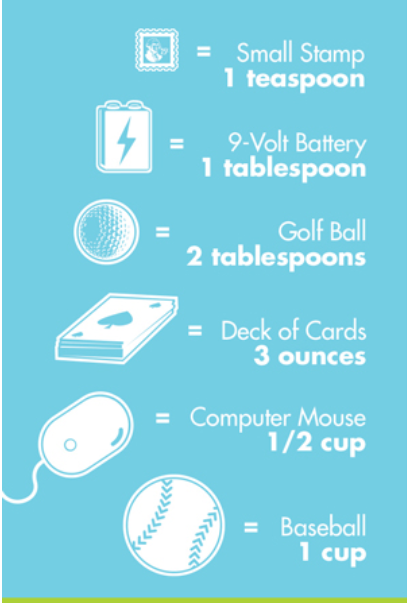Nutrition: Visualizing Portion Sizes with Household Objects
Visualizing Portion Sizes with Household Objects

Serving sizes and portion sizes are not one and the same. Serving size refers to a standardized quantity on the package or nutrition label, while portion size is the amount you choose to eat at that moment.
You do not need to restrict yourself to eating only one serving of a food. If you still feel hungry after, that may mean your body needs more energy to feel full and content. An appropriate portion for you may be smaller or larger than the serving size, and that’s okay! Listening to our hunger and satiety cues is an important component of mindful eating.
Using visual tools to estimate portion sizes can be a great strategy to be mindful of what you’re eating without using exact measuring tools.
- Baseball = 1 cup
- Vegetables, whole fruit, cereal
- Tennis ball or computer mouse = ½ cup
- Pasta, rice, oats, baked potato
- 3 playing dice = 1 oz
- Hard cheese, nuts
- Deck of cards (or 2-3 CDs for sliced meats) = 3 oz equivalent
- Protein (chicken, beef, meat, fish)
- Golf ball = 2 tbsp
- Nut butters, salad dressing
- Postage stamp = 1 tsp
- Oils
If you are monitoring intake of certain nutrients, like saturated fat, sodium, or calcium, for example, don’t forget to consider how many servings of a food you ate and multiply the numbers on the nutrition label accordingly. For example, if one serving of peanut butter (2 tablespoons) provides 7 grams of protein, and you ate two servings, 7 x 2 = 14 grams of protein from the peanut butter. The same math works for portions that are smaller than the standardized serving. If one cup of ice cream contains 10 grams of saturated fat, but you only ate ½ cup, then 10 x ½ = 5 grams of saturated fat.
Nutrient needs vary depending on many factors, including age, sex, activity level, and health history. For individualized recommendations, consult with a Registered Dietitian Nutritionist (RDN) to determine what works best for your needs and lifestyle.
By Registered Dietitian Inna Kagan


 Home Base
Home Base